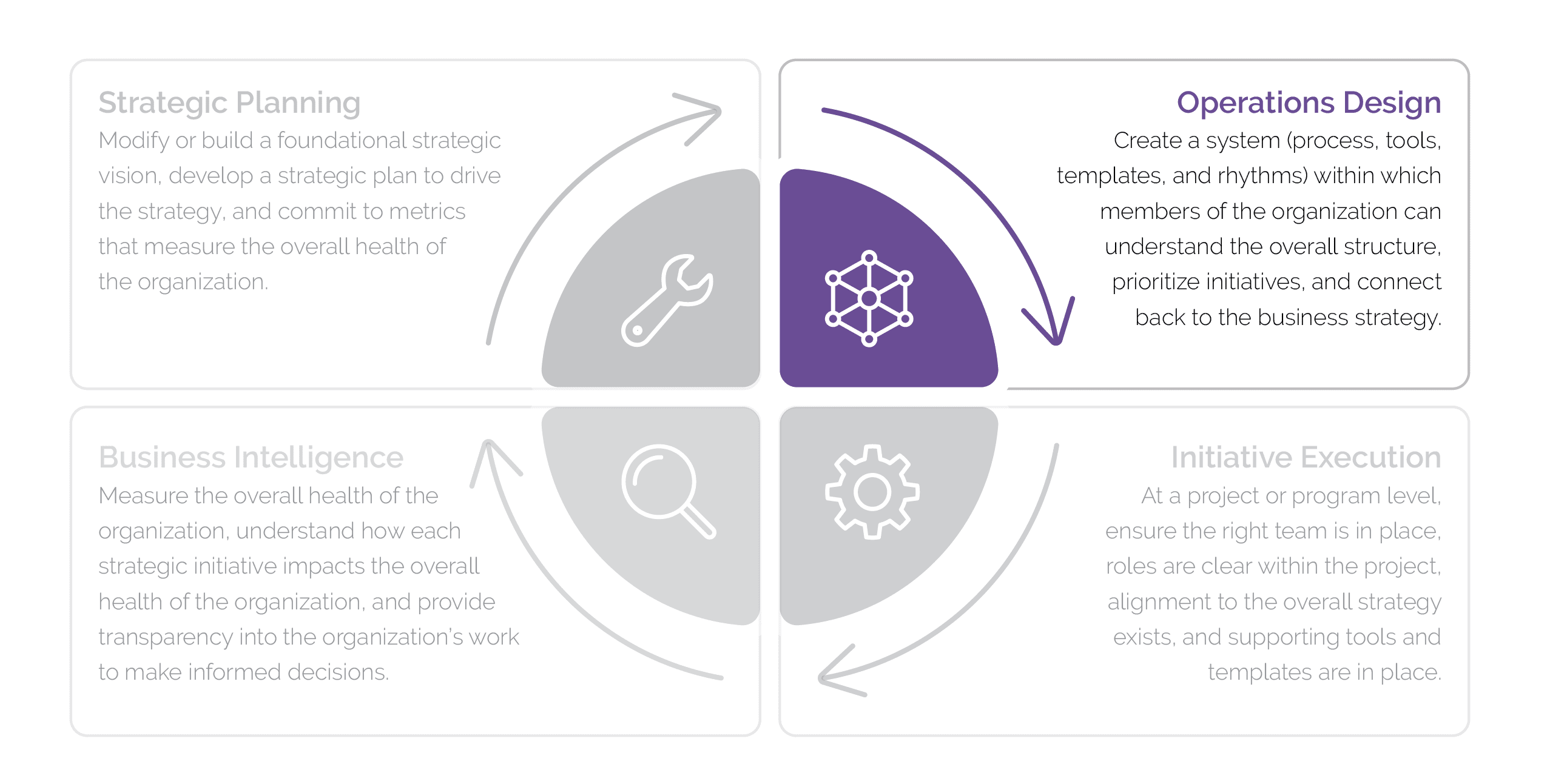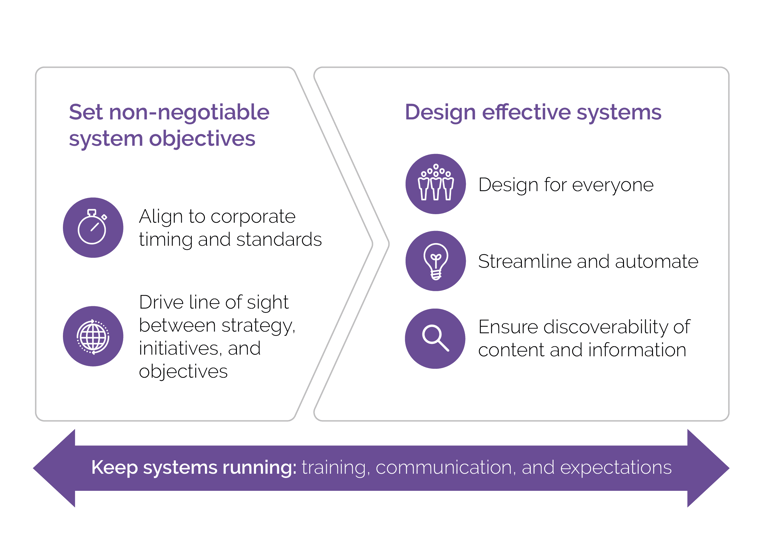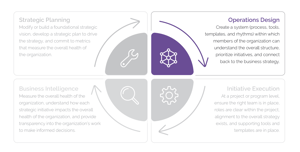At the heart of efficient daily operations lies your business process design. By analyzing and redesigning key business processes where necessary, you can streamline workflows, eliminate redundancies, and improve productivity. Business process design is the first step in creating a strong operational framework that supports long-term growth.
Spur Reply defines good business operations systems as an interconnected collection of processes, tools, templates, timelines, and rhythms of a business.
Establishing a robust, enduring, and efficient system sounds simple. So why don’t most companies have smoothly running business operations?
Because design and implementation are hard and often neglected. Companies often rush into executing their strategies without checking if they have the necessary support system in place.
Achieving operational success is not a quick fix. It takes commitment from the organization. Additionally, many key stakeholders do not understand the value of operational design or consider it a top priority.
Not investing adequate time, energy, and budget into good business operations design can pose serious consequences. You and your team risk wasting time, being ill-equipped for common or repetitive tasks, and getting confused or burned out. Additionally, without a well-designed system, the best strategies and the best execution can fail. Even a small change to one system can cause a ripple effect that leads to negative outcomes.

A good operations system boosts team productivity, allowing people to complete day-to-day tasks faster and better collaborate across the organization.
A well-run organization benefits customers, employees, and your bottom line. We recommend these three key steps for success in operations design:
This is the third in a 5-part blog series defining Spur Reply’s unique perspective on the often overlooked, but incredibly valuable world of business operations.
Part 1: Overall business operations
Part 2: Strategic planning
Part 3: This blog focuses on operations design
Part 4: Initiative execution
Part 5: Business intelligence
1. Set non-negotiable system objectives
Align to corporate timing and standards
To be successful, operations must clearly align with your organization's overall system. Designing operations and systems without considering internal and external impacts may create confusion, inconsistencies, and inefficiencies. A business operations system that you create should align with, support, and balance existing corporate systems.
As you establish your new rhythm, use the existing frameworks as a baseline. For instance, make sure teams can access the most up-to-date data and reports before important meetings with company leaders. Additionally, to save on the amount of time it takes to create new content, consider reusing existing content for different purposes. This can help reduce the need for constant creation.
To make things easier, we suggest creating a detailed timeline of all the action items your teams need to complete. While timelines are usually used for initiatives, they can also be helpful for the whole organization. Context and relevant timelines will allow you to kick off developing more effective operations and systems.
Create transparency among strategy, initiatives, and metrics
Your operations design should always tie back to your strategic plan, which will sustain progress and ensure you achieve the right goals. Without creating and maintaining transparency among teams, information is inconsistent, and success becomes less attainable.
We often see organizations separate operations design from their strategy, viewing them as two isolated pieces of the business. However, those teams often fail to meet strategic objectives.
2. Design effective systems
Align your strategy and operations
Agility and efficiency are crucial to maintaining competitive differentiation. To stay agile and efficient, your strategy and operations must remain aligned.
The way you manage your strategic objectives underscores the significance of design in operations management. Effective operational design goes beyond mere execution—it involves intentional planning and structuring of processes to align with overarching strategic goals. To succeed in a competitive environment, focus on planning operations with a future-oriented approach. Be prepared for upcoming needs and obstacles.
Design for everyone
Any
Any system design is only as good as the participation in it.
Make sure all teams and stakeholders are able and willing to execute the processes, use the tools, and adhere to the rhythms you establish. A common mistake we see is a business operations system designed exclusively for the organization’s leader. While this may sound logical, it often results in a burdensome system that removes focus on important work for the rest of the team.
As you design your business operations system, consider the extended team, management, stakeholders, and anyone else the system will affect. Also consider where your outputs go, your dependencies, and the upstream rhythm of business impact.
Streamline and automate
To get everyone on board with a new operations system, make sure it lightens their workload.
Organizations often make the mistake of designing systems without considering the work required to run them effectively. As you design your organization’s business operations system, inventory:
- Which steps are necessary
- Which steps can be removed
- The effort required to complete each step
- The return you expect to get from each
Remember, if a system is overly complicated, adoption will be slow and thereby stall progress.
First, start with the most critical processes and evaluate them for improvement. Determine which steps are adding value and which are not. Be sure to investigate which tools or processes make project management easier.
You should also identify the potential breakage points, which are potential innovation areas. For example, you could implement a simple portal with the agenda for the month’s business review. A portal can save hours in email conversations.
As you evaluate each process, focus on reducing effort, particularly in the long term. An extra 30 minutes per week of entering semi-important data may not seem significant; but at the end of the year, that task adds up to more than 24 hours.
If a tool or process isn’t providing value to your organization, don’t wait to fix it. Instead, we suggest you identify areas to automate and innovate. Automating manual, tedious tasks will free up time for you to focus on analyzing insights and other important activities. You can make this shift by using AI, RPA (Robot Process Automation), and other related solutions.
In addition, new processes often take slightly longer in the beginning as teams and individuals start to adopt them. If a new process seems to be moving slowly at first, no need to assume it’s a bad process. Instead, think of the time as a ramp-up period as people adjust to a new way of working.
Ensure content and information are easy to find
A well-run team is a well-informed team.
If your systems and tools are difficult to navigate, company leaders or teams may lose interest and not want to waste time seeking help. Overly complicated systems or tools can impact productivity and efficiency. You should provide easily accessible information and resources to help people navigate the change.
Keep the information accessible and organize resources in logical categories. As an example, design tools and processes that leverage a consistent set of colors or icons. This will make it easy to identify various resources throughout the system.

3. Keep systems running
Training
Effective training helps your system operate correctly. Without proper training, you are gambling on word-of-mouth and hope (as we like to say, ‘hope’ is not strategy).
Approach training proactively. Some people need software support, while others might need communication skills.
Don’t expect your stakeholders to figure the new systems out on their own. Eventually, they may, but it will be inconsistent across the organization and at the expense of other key initiatives. Operations teams should support early and often.
Communication
Communicating any updates or changes to a business operations system is crucial. If your communication is late or unclear, you risk losing trust and participation in the system.
Buy-in is much tougher to achieve when employees are confused or doubt your approach. To avoid this, build a consistent feedback loop. You can implement changes as appropriate or explain why you didn't implement them when necessary. Be sure to prioritize communication throughout the process to increase adoption and signal the effort’s priority.
Expectations
Effective business operations system changes require that the business lead set proper expectations. Confusion about expectations can be a huge cause of stress in the workplace. You’ll want to set clear expectations on how individual team members contribute to the system. Report on the status regularly and ensure the timeline and meeting cadence is clear.
The team needs to adhere to the business operations system and work collaboratively to meet key milestones. Team members should also understand suggestions and modifications are always welcome, but participation is a requirement.

Operational design is ever-evolving
Any time you find yourself saying, “Well, this is how we’ve always done it,” stop and re-evaluate. You can most likely improve existing processes to become more efficient and effective. Streamlining and optimizing your systems and processes will lead to higher-valued products or services in the long run.
The journey toward operational excellence begins with embracing the principles of operational design in your business strategy. By thoughtfully and purposefully integrating strategy and operations, you will be better positioned as a leader in the ever-evolving technology landscape.
Designing operations is not a one-time endeavor; it's an ongoing process that requires continuous evaluation and adaptation. Embrace a culture of innovation, constant improvement, and problem-solving to stay ahead of the curve.
Check out our other blogs in the series:
Part 1: Overall business operations
Part 2: Strategic planning
Part 4: Initiative execution
Part 5: Business intelligence


